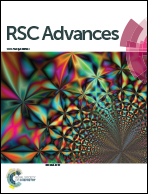Norbornene derived nanocarrier reduces isoniazid mediated liver toxicity: assessment in HepG2 cell line and zebrafish model†
Abstract
The aim of this study was to investigate the protective effect of the stimuli-responsive norbornene-based nanocarrier complex of isoniazid, compared to pure isoniazid, on liver cells, by in vivo and in vitro methods. Hepatic damage induced in a zebrafish model by isoniazid resulted in significant alterations in liver histology, gene expression of drug metabolizing genes, reduced glutathione (GSH) levels, and DNA damage. An increased level of intracellular reactive oxygen species (ROS) was detected in HepG2 cells on exposure to isoniazid. Interestingly, the isoniazid conjugated nanocarrier exhibited a more protective effect on liver cells compared to isoniazid. A significant reduction in the cyp2p6 gene, elevation in GSH levels, reduced DNA damage, and a normal histological tissue pattern was observed in liver tissues exposed to the isoniazid conjugated nanocarrier. Also, the isoniazid conjugated nanocarrier showed negligible ROS generation and in vitro cytotoxicity in HepG2 cells. These encouraging results may prompt further research in the advance of norbornene-based nano systems in nanotherapeutics and biomedical applications.


 Please wait while we load your content...
Please wait while we load your content...